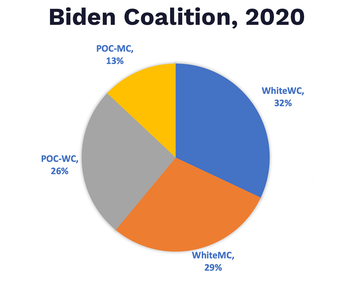
Americans without bachelor’s degrees outnumber college grads 2 to 1. But if you and most people you know and have ever known are college graduates, you might not realize that most Americans are not like you and your cohort. As a result, you’re likely to think your class of people is much, much larger than it is.
That misunderstanding is crucial for American politics in the early 21st century. As David Shor and others have pointed out, most political operatives and activists – and perhaps especially Democrats — are college grads who seem to assume that most voters are like them.
Likewise, most network and cable TV reporters and commentators also often seem to assume that almost everybody has been to college. They might get the right answer on a true-or-false question if somebody asked, but nobody does. And, thus, there is a feedback loop among the political and pundit class: they don’t realize that they are engaged in a public inter-class conversation that is code-restricted to those who have graduated from college – and maybe even only to those who have graduated from the most elite schools.
For the past two decades, Ruy Teixeira and a handful of other progressive Democratic analysts have been banging their heads against this wall, trying to convince Dems to pay more attention to working-class whites, defined as whites without bachelor’s degrees, and now raising alarms about the erosion of Black and Hispanic working-class voters as well. Teixeira’s latest effort on the coming mid-term elections shows how the political class shapes issues based on unconscious or semi-conscious class bias: focusing on abortion, Trump’s corruption, gun control, and January 6th – issues top of mind among the college-educated – to the exclusion of economic issues, including inflation and its effects on real wages, that matter most to working-class voters of all colors.
I sympathize with Teixeira’s frustration with the class tilt of Democratic Party professionals and most of the media, but I think he presents too uniform a view of the party, one that may be accurate in the D.C. – New York corridor but much less so across the country. President Biden has repeatedly emphasized working-class issues, for example, as have several Democratic Congressional candidates, like Tim Ryan in Ohio.
But the party can’t ignore issues like abortion and Trumpian corruption for both principled reasons and because it is a cross-class, multi-racial coalition that cannot work without all of its parts.
Democratic data firm Catalist makes the challenge clear: Democrats are still a mostly working-class party, as 58% of Biden voters, all colors, did not have bachelor’s degrees. But the other 42% of the coalition did, and Democrats cannot ignore either group’s interests. The picture gets more complicated when we factor in race. Catalist groups Blacks, Hispanics, Asians, and “Others” together as people of color (POC), and they made up 39% of the Biden coalition.
Read the rest of this piece at Working-Class Perspectives.
Jack Metzgar is a retired Professor of Humanities from Roosevelt University in Chicago, where he is a core member of the Chicago Center for Working-Class Studies. His research interests include labor politics, working-class voting patterns, working-class culture, and popular and political discourse about class. He is a former President of the Working-Class Studies Association.












